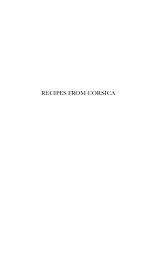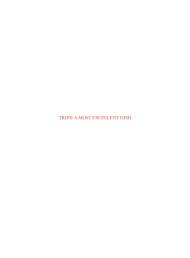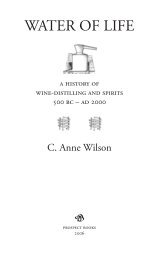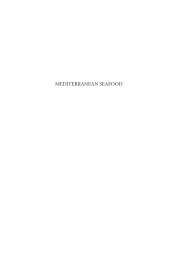THE REALM OF FIG AND QUINCE - Prospect Books
THE REALM OF FIG AND QUINCE - Prospect Books
THE REALM OF FIG AND QUINCE - Prospect Books
Create successful ePaper yourself
Turn your PDF publications into a flip-book with our unique Google optimized e-Paper software.
<strong>THE</strong> <strong>REALM</strong> <strong>OF</strong> <strong>FIG</strong> <strong>AND</strong> <strong>QUINCE</strong>
<strong>THE</strong> <strong>REALM</strong> <strong>OF</strong> <strong>FIG</strong> <strong>AND</strong> <strong>QUINCE</strong><br />
FROM MESOPOTAMIA TO <strong>THE</strong> MAGHREB<br />
Ria Loohuizen<br />
author of<br />
The Elder<br />
On Chestnuts<br />
Translated from the Dutch<br />
by<br />
ALISSA VALLES<br />
PROSPECT BOOKS<br />
2010
First published in Great Britain in 2010 by <strong>Prospect</strong> <strong>Books</strong>, Allaleigh House,<br />
Blackawton, Totnes, Devon TQ9 7DL.<br />
This book, entitled Het rijk van kwee en vijg<br />
by Uitgeverij Atlas, Amsterdam in 2003.<br />
© 2003, 2010, Ria Loohuizen.<br />
© 2010, the translation, Alissa Valles.<br />
<br />
<br />
Copyright, Designs & Patents Act 1988.<br />
BRITISH LIBRARY CATALOGUING IN PUBLICATION DATA:<br />
A catalogue entry for this book is available from the British Library.<br />
No part of this publication may be reproduced, stored in a retrieval system or<br />
transmitted in any form or by any means, electronic, mech anical, photocopying,<br />
recording or otherwise, without the prior permission of the copyright holder.<br />
ISBN 9781903018743<br />
Typeset by Tom Jaine.<br />
Printed in Great Britain at the Cromwell Press Group, Trowbridge.<br />
4
Contents<br />
Preliminaries<br />
I Introduction and itinerary 9<br />
II <br />
<br />
III <br />
<br />
IV <br />
V The historical quince 27<br />
VI The botanical quince 30<br />
VII The medicinal quince 34<br />
VIII A short history of sugar 37<br />
IX Membrillo: theme and variations 42<br />
<br />
X MesopotamiaPersia 49<br />
XI Turkey 59<br />
XII <br />
<br />
XIII <br />
XIV France 91<br />
XV Spain and Portugal 103<br />
XVI The Maghreb 119<br />
Bibliography 141<br />
Index 143<br />
5
<strong>THE</strong> <strong>REALM</strong> <strong>OF</strong> <strong>FIG</strong> <strong>AND</strong> <strong>QUINCE</strong><br />
<br />
<br />
I have listed in the bibliography the books I have consulted<br />
and in which I came across the quotations inserted in the<br />
text. Several have provided the ideas behind many of the<br />
recipes; I am very grateful for their pioneering work.<br />
<br />
<br />
Clare Pawley.<br />
I am also thankful to my daughter, Alissa Valles, for the<br />
translation she made from the Dutch, as well as for her<br />
sound and humorous advice.<br />
<br />
<br />
Angeles, sent me very interesting information and articles,<br />
for which I am in his debt.<br />
Cooking notes<br />
When I mention olive oil in the recipes, I mean extra<br />
<br />
<br />
<br />
leaved<br />
kind.<br />
Unless otherwise stated, the recipes are for 4 people.
<strong>THE</strong> <strong>REALM</strong> <strong>OF</strong> <strong>FIG</strong> <strong>AND</strong> <strong>QUINCE</strong><br />
<br />
Oven temperatures<br />
<br />
<br />
275°F 140°C Gas 1 Cool<br />
300°F 150°C Gas 2<br />
325°F 170°C Gas 3 Moderate<br />
350°F 180°C Gas 4<br />
375°F 190°C Gas 5<br />
<br />
425°F 220°C Gas 7<br />
450°F 230°C Gas 8 Very hot<br />
475°F 240°C Gas 9<br />
<br />
<br />
<br />
<br />
<br />
<br />
<br />
<br />
7
<strong>THE</strong> <strong>REALM</strong> <strong>OF</strong> <strong>FIG</strong> <strong>AND</strong> <strong>QUINCE</strong><br />
8
<strong>THE</strong> FIRST ORCHARD<br />
<br />
<br />
<br />
<br />
<br />
<br />
<br />
<br />
<br />
<br />
<br />
Genesis 2:814<br />
T o begin at the beginning, we begin at the Beginning:<br />
Genesis. Where on the newly created earth did the<br />
Great Gardener plant his Garden of Eden, between those<br />
four named rivers? The indications are vague: ‘eastward’.<br />
When we think of the Middle East, the Holy Land, what<br />
suggests itself is the image of a desert: yellow and arid,<br />
not green and fertile. One exception to this is the fertile<br />
<br />
<br />
The majority of historians accept that the First<br />
Orchard was located in the area between the Euphrates<br />
9
<strong>THE</strong> <strong>REALM</strong> <strong>OF</strong> <strong>FIG</strong> <strong>AND</strong> <strong>QUINCE</strong><br />
10<br />
and Tigris rivers in ancient Mesopotamia or what is now<br />
Iraq. It is an area that stretches northwards from the<br />
Persian Gulf to the mountains of Armenia and to the east<br />
from the Syrian desert to the Zagros mountains. Crucially,<br />
it contains a fertile alluvial plain, irrigated in antiquity by a<br />
network of canals. The southern part of this area has long<br />
been considered the cradle of civilization, even if today it<br />
<br />
If the Tigris and Euphrates are two of the rivers of<br />
Eden, then the Gihon named in Genesis may possibly be<br />
the Nile, described as encompassing ‘the whole land of<br />
<br />
<br />
Bible scholars and theologians of all denominations<br />
<br />
<br />
rivers of the Creation and their debates sometimes yield<br />
interesting theories. One of them is worth mentioning,<br />
if only because it sets the world on its head.<br />
Mormons regard the ‘Book of Moses’, discovered in<br />
the early 1800s by the famous Egyptologist Champollion<br />
in what was believed to be a royal casket and bought for<br />
<br />
Christ of Latter Day Saints, as part of holy scripture. The<br />
Mormon interpretation of this book, and of Genesis, is<br />
<br />
<br />
<br />
Mormons believed the confluence of the Mississippi,<br />
Missouri, Ohio and Illinois rivers is the only geographical<br />
location that conforms to the description in Genesis.
INTRODUCTION <strong>AND</strong> ITINERARY<br />
<br />
<br />
and quince from their paradisal origins to the markets and<br />
tables of today. These fruits travelled with the Medes and<br />
Persians of ancient times, and then with the Phoenicians,<br />
Greeks and Romans; a voyage that led through Turkey,<br />
Greece, Italy, France, Spain and North Africa. As we<br />
follow them in search of the most delicious recipes, we are<br />
accompanied by poets and prose writers, cartographers<br />
and artists. What better point of departure than the<br />
Garden of Eden?<br />
<strong>THE</strong> FIRST BITE<br />
<br />
in her mind<br />
<br />
<br />
<br />
<br />
<br />
<br />
D.H. Lawrence,<br />
‘Figs’ from <br />
, 1923<br />
The history of food has an ominous beginning: some one<br />
bites into an apple and look at the consequences! After<br />
<br />
opened, and they knew that they were naked’. How do<br />
<br />
<br />
<br />
<br />
11
<strong>THE</strong> <strong>REALM</strong> <strong>OF</strong> <strong>FIG</strong> <strong>AND</strong> <strong>QUINCE</strong><br />
12<br />
<br />
<br />
<br />
in human history. One leaf was evidently not enough to<br />
<br />
<br />
and paintings have to do with just one. The Bible contains<br />
<br />
<br />
trees were common in Palestine. The passage ‘every man<br />
<br />
<br />
a time of happiness, prosperity, safety and security: the<br />
ultimate life of peace and wellbeing.<br />
<br />
<br />
Theocritus, <br />
<br />
BC<br />
<br />
<br />
fabric of Eden than mere modest coverall. These claim
INTRODUCTION <strong>AND</strong> ITINERARY<br />
Creation mosaics in St Mark’s in Venice depict just this<br />
interpretation of the myth.<br />
<br />
<br />
real <br />
<br />
dried version. The great expectations I had, freed at last<br />
<br />
youth, were crushed. I had an ‘Is that all?’ feeling similar<br />
<br />
of leafpulling and choking I was left with a great pile of<br />
<br />
A few years later, when I went to live in California, a<br />
veritable cornucopia, my culinary awareness developed<br />
with alarming speed and for months I ate something<br />
new, something I had never eaten before, every week.<br />
At the end of my decade on that coast there were still<br />
some products I hadn’t tasted. In these times of winter<br />
strawberries and summer cabbages this may be hard to<br />
imagine, but until the early seventies, I did not know<br />
zucchini, or pumpkin, parsnip, papaya, broccoli or even<br />
bell peppers let alone the dozens of varieties of fresh<br />
greens and root vegetables that were on offer there.<br />
<br />
<br />
learned to appreciate what Elizabeth David calls ‘one of<br />
the exquisite pleasures of the Mediterranean’: picking a<br />
<br />
open and devouring it on the spot. And I learned to deal<br />
with the abundant summer harvest by making jams, tarts<br />
and preserves. This period has left me with a soft spot<br />
13
<strong>THE</strong> <strong>REALM</strong> <strong>OF</strong> <strong>FIG</strong> <strong>AND</strong> <strong>QUINCE</strong><br />
14<br />
for one of the softest, most delicate of fruits, which in its<br />
dried state can be tough as leather one of the enduring<br />
contradictions in nature.<br />
<strong>THE</strong> GOLDEN APPLE<br />
<br />
<br />
<br />
<br />
<br />
<br />
<br />
<br />
<br />
<br />
<br />
<br />
<br />
<br />
<br />
<br />
AD<br />
<br />
<br />
<br />
role in Greek myth and is by many assumed to be the<br />
‘golden apple of the Hesperides’, which Hercules seeks<br />
in one of his labours.<br />
For years I had admired these old fruits, covered<br />
with their strange down, in the stilllifes painted in the<br />
seventeenth century, and in the markets of France and<br />
Spain. When I started to cook with them, it was magic<br />
to see those hard yellow astringent things turn into the<br />
colour of the most exquisite orange gem. Membrillo, quince
INTRODUCTION <strong>AND</strong> ITINERARY<br />
paste or quince cheese, was an ubiquitous item in Spain,<br />
where it was served with a piece of old Manchego cheese, a<br />
classic combination. When I returned to the Netherlands<br />
<br />
and Morocco, and from their surprising cuisine I learned<br />
how to combine fruit and meat, for which the quince,<br />
<br />
eminently suitable.<br />
<br />
<br />
15
The fig is a mysterious fruit with many special<br />
properties and huge sex appeal. The fruit is often<br />
compared to the female genitalia, but at the same time is<br />
associated with the male sex.<br />
<br />
<br />
<br />
<br />
<br />
<br />
<br />
D.H. Lawrence,<br />
‘Figs’ from <br />
, 1923<br />
For the Hellenes it was the sacred fruit of the lustful and<br />
everthirsty god Dionysus. If the fruit seems to mimic the<br />
female pudenda, the tree is often thought to represent<br />
<br />
<br />
on the grave of Polyhymnos instead of carrying out a<br />
<br />
<br />
wood is carried aloft on the festivals and feast days of<br />
<br />
<br />
a symbol of modesty.
<strong>THE</strong> HISTORICAL <strong>FIG</strong><br />
<br />
<br />
<br />
It was this customary symbolism that prompted<br />
<br />
Satire, ‘I was once the trunk<br />
<br />
<br />
<br />
<br />
determined that I should be a god.’<br />
Roman mythology has it that Romulus and Remus were<br />
suckled by the she<br />
<br />
which had stayed their basket when adrift on the Tiber.<br />
17
<strong>THE</strong> <strong>REALM</strong> <strong>OF</strong> <strong>FIG</strong> <strong>AND</strong> <strong>QUINCE</strong><br />
18<br />
<br />
<br />
and well<br />
<br />
is a prophecy of riches, good fortune and a happy old age.<br />
<br />
<br />
<br />
or something that<br />
comes too late. The greening of the tree was thought by<br />
the Greeks to herald the coming of spring: ‘When a man<br />
<br />
tree as large as the mark that a crow<br />
makes, then is the spring sailing time,’ wrote Hesiod.<br />
<br />
<br />
bodied in the universal Mediterranean gesture of ‘the
<strong>THE</strong> HISTORICAL <strong>FIG</strong><br />
. Partridge explains in his <br />
: ‘A<br />
contemptuous gesture made by thrusting the thumb forth<br />
<br />
<br />
have been, but it was also an amulet <br />
spirits or an invitation to dalliance: you guessed which<br />
<br />
maker. Calumny and insult<br />
was the general idea in earlymodern Europe, however, as<br />
Pistol thought in Henry V: ‘A for thy friendship!’ The<br />
<br />
<br />
<br />
Here too is the origin of the expression, ‘I don’t give a<br />
<br />
<br />
<br />
with something more earthy.<br />
<br />
<br />
fertile area in the south of ancient Arabia. It is certain<br />
<br />
BC<br />
BC<br />
<br />
gradually reached Syria, Turkey and the Mediterranean,<br />
helped along by the industriousness and colonial drive of<br />
sea<br />
BC it could be found<br />
on Crete. The Phoenicians and Greeks were responsible<br />
<br />
<br />
The Phoenicians colonized the islands of Cyprus, Rhodes,<br />
Sicily, Malta and Corsica, followed by the coastal regions<br />
of North Africa. Archaeological research has established<br />
<br />
<br />
colonies than in their homelands.<br />
19
<strong>THE</strong> <strong>REALM</strong> <strong>OF</strong> <strong>FIG</strong> <strong>AND</strong> <strong>QUINCE</strong><br />
20<br />
<br />
<br />
luxurious article; they were presented as medals or strung<br />
into wreaths for Olympic athletes. Fig trees were sacred,<br />
and it was forbidden to export them, and those who did so<br />
were reported to the authorities by socalled sycophants.<br />
<br />
<br />
three times in Homer’s , thought to have been<br />
composed in approximately the ninth century BC. From<br />
<br />
<br />
<br />
tree features in the myth of Rome’s founding.<br />
Seventeen hundred years after Phoenician colonization,<br />
the same trading routes were travelled by the Moors, who<br />
<br />
<br />
<br />
<br />
fruit.
Quince: <br />
Fig: <br />
<br />
<br />
<br />
<br />
AD 55<br />
The best and most relaxed way to travel from Greece<br />
to Italy is by boat, from Piraeus through the Strait of<br />
Messina to Naples. We now leave the Middle East behind<br />
but linger a little while with the goats and their shepherd<br />
<br />
<br />
In Italy there are many goat’s and sheep’s milk cheeses,<br />
like , which are sharp and excellently suited to<br />
<br />
<br />
there is also soft cheese, the bestknown kind being the<br />
southern <br />
, which is sadly never at its<br />
best outside its native region it should really be no more<br />
than a day old.<br />
When I once spent several months on Procida, the<br />
<br />
<br />
morning by a typical Italian sound: a scooter’s sputtering.
ITALY<br />
I looked out of the window and saw a scene straight out of<br />
a Vittorio de Sica movie: something between a scooter and<br />
a bicycle cart, the Italian equivalent of a rickshaw often<br />
used as a taxi in the south, had parked in the street below.<br />
<br />
and going away holding what looked like a boiled egg or a<br />
whole bag of boiled eggs. It was only the next day that I<br />
recovered from my culinary jetlag and realized these were<br />
balls of mozzarella. The cart carrying fresh wares arrived<br />
every day by boat from Pozzuoli and the villages in the<br />
<br />
older mozzarella you are looked at askance. At most the<br />
cheese is then used for pizza, with nothing more than a<br />
clutch of basil.<br />
<br />
<br />
<br />
.<br />
Figs are also dried in Italy; in Bari on the Adriatic coast<br />
they add almonds, fennel seeds and bay leaves for an<br />
<br />
Mosaics and murals from Pompeii show that the quince<br />
was also prized in ancient Roman times. Pliny the Elder,<br />
one of the victims of the famous eruption of Vesuvius<br />
<br />
<br />
his wonderful <br />
. In the same way as we can<br />
read in Apicius’ <br />
, he described a method<br />
for enlarging a pig’s liver before slaughter by feeding it<br />
<br />
called .<br />
77
<strong>THE</strong> <strong>REALM</strong> <strong>OF</strong> <strong>FIG</strong> <strong>AND</strong> <strong>QUINCE</strong><br />
78<br />
The quince occurs in the famous banquet of Trimalchio,<br />
<br />
<br />
AD, and on the<br />
menu of a banquet given by Pope Pius V in 1570. A quince<br />
pie was served on the latter occasion, with the special<br />
note that a whole fruit was to be used per head.<br />
First I will give the recipes for several sauces which can<br />
be served either with roasted meat or poultry or on bread<br />
with an Italian cheese gorgonzola, Parmigiano, pecorino,<br />
<br />
<br />
<br />
’ which, according to Elizabeth David, dates from<br />
antiquity and in northern provinces is also sometimes
ITALY<br />
MOSTARDA DI COTOGNA <strong>QUINCE</strong> MUSTARD<br />
This closely resembles a relish or chutney and is used in<br />
the same way. It is usually made with a mixture of fruits in<br />
a thickened sweetandsour syrup with herbs and/or spices.<br />
For the Italian those of Venice and Cremona<br />
being the most celebrated there are various methods<br />
of preparation: with sugar or honey; with mustard oil,<br />
powder or seed; with wine or with water. It is, in a manner<br />
of speaking, Liberty Hall, and each cook can make his or<br />
her mark on the recipe. Here are two of mine.<br />
Quince is a speciality of the northern Italian<br />
town of Vicenza. Elizabeth David tells of visiting Venice in<br />
<br />
<br />
purchases would ensure that stocks were exhausted by<br />
Christmas.<br />
<br />
<br />
<br />
<br />
<br />
<br />
<br />
<br />
<br />
<br />
<br />
79
<strong>THE</strong> <strong>REALM</strong> <strong>OF</strong> <strong>FIG</strong> <strong>AND</strong> <strong>QUINCE</strong><br />
80<br />
Put all the ingredients except the lemon juice in a pan<br />
with a heavy bottom, bring to a boil while stirring and let<br />
simmer on very low heat for an hour to an hour and a half,<br />
until thickened. Stir regularly, especially the last half hour,<br />
so that the mixture does not stick to the pan.<br />
Remove the pan from the cooker and stir in the lemon<br />
juice. Let the cool and put it in clean jars. Seal<br />
and keep cool.<br />
<br />
<br />
<br />
<br />
<br />
<br />
<br />
Cut the fruit into small pieces and put it just under water<br />
in a thickbottomed pan. Add 1 tablespoon of honey and<br />
the grated peel of a lemon.<br />
Cook the fruit for 30 minutes on medium heat without<br />
cover. Stir from time to time. Let cool.<br />
Warm the wine in another pan with the rest of the<br />
honey. Boil the syrup down to a third of its volume and<br />
stir in the mustard seeds. Let cool.<br />
Mix the fruit mixture with the honey syrup, put<br />
in preserving jars and let the thicken in the<br />
fridge.
SALSA DI FICHI CON ACETO BALSAMICO<br />
ITALY<br />
<strong>FIG</strong> SAUCE WITH BALSAMIC VINEGAR<br />
Few food items have been so in vogue during the last<br />
decade as balsamic vinegar and it has gone from being<br />
<br />
<br />
history can be traced back to Columbus: among the many<br />
novelties and souvenirs he brought back from his second<br />
journey to the New World were a few cuttings of the<br />
<br />
Abies balsamea<br />
in southern Europe. The wood is mainly used in Italy to<br />
make barrels in which the extraordinarily mild vinegar<br />
made from the white Trebbiano grape is ripened. It is<br />
the oily, aromatic resin in the balsam wood that gives<br />
the Modena vinegar its distinctive aroma and flavour,<br />
and the rule is that the longer it is left to mature in the<br />
barrels, the fuller and smoother it gets. As with wine there<br />
are balsamic vinegars with an ‘appellation contrôlée’, a<br />
denomination of origin and vintage, and some bottles<br />
come with a price tag of more than 100 Euros.<br />
<br />
<br />
<br />
<br />
<br />
<br />
Put all the ingredients in a pan with half a cup of water.<br />
Cover with a lid and bring to a boil. Turn down the heat<br />
81
<strong>THE</strong> <strong>REALM</strong> <strong>OF</strong> <strong>FIG</strong> <strong>AND</strong> <strong>QUINCE</strong><br />
82<br />
and keep the pan half covered by the lid. Cook slowly for<br />
about half an hour.<br />
Remove the thyme twigs and press the mixture through<br />
a coarse sieve with a wooden spoon, or use a food mill if<br />
<br />
POLENTA CON FICHI E MASCARPONE<br />
POLENTA WITH <strong>FIG</strong>S <strong>AND</strong> MASCARPONE<br />
A breakfast that will keep you going until it’s time for<br />
antipasti.<br />
<br />
<br />
<br />
<br />
mascarpone<br />
<br />
Bring the milk to a boil and stir in the polenta. Reduce the<br />
heat to low and keep stirring until the polenta is creamy,<br />
about 2 minutes.<br />
Stir in the butter and the . Put the fig<br />
segments on top and drizzle with honey.<br />
<br />
<br />
as lunch or starter dishes.
INSALATA DI FICHI E MOZZARELLA<br />
<strong>FIG</strong> <strong>AND</strong> MOZZARELLA SALAD<br />
ITALY<br />
<br />
<br />
<br />
<br />
<br />
<br />
<br />
<br />
Slice the mozzarella thinly and arrange on a plate.<br />
Mix the two oils, the crushed garlic, the juice of the<br />
lemon and the salt and pepper.<br />
Pour the dressing on the mozzarella and let it marinate<br />
in the fridge for 1 hour or more. Turn the slices over<br />
several times.<br />
<br />
<br />
<br />
plate and pour the dressing over them. Grind some fresh<br />
black pepper over them and garnish with the basil.<br />
83
<strong>THE</strong> <strong>REALM</strong> <strong>OF</strong> <strong>FIG</strong> <strong>AND</strong> <strong>QUINCE</strong><br />
INSALATA STROMBOLI STROMBOLI SALAD<br />
84<br />
<br />
Stromboli<br />
<br />
<br />
truth of the notion that the quickest way to the heart<br />
is through the stomach, while eating the following salad.<br />
<br />
<br />
<br />
half a fennel bulb<br />
<br />
<br />
<br />
olive oil<br />
pepper<br />
Roast the capsicums until the skin begins to blister. Put<br />
<br />
<br />
peppers cool for half an hour, until they are cool enough<br />
to handle. Peel them and cut them into strips.<br />
Drain the anchovies and peel the potatoes. Cut the<br />
potatoes in thin slices and the anchovies into pieces. Wash<br />
the fennel, remove the outer stalks if necessary and cut<br />
the bulb into slices.<br />
<br />
<br />
<br />
peppers and anchovies on top, together with the capers<br />
and some of their juice. Sprinkle with mint leaves.
ITALY<br />
Put the plate in the fridge for a few hours to let the<br />
flavours mingle and sprinkle with olive oil just before<br />
<br />
do add black pepper to taste.<br />
INSALATA DI RUCOLA CON FICHI ROCKET SALAD WITH <strong>FIG</strong>S<br />
<br />
<br />
<br />
<br />
<br />
<br />
salt<br />
<br />
Wash the rocket and put it in a bowl.<br />
<br />
<br />
slices.<br />
Brown the pine nuts lightly in olive oil, sprinkle them<br />
<br />
Make a dressing with the olive oil and orange juice and<br />
serve it on the side.<br />
85
<strong>THE</strong> <strong>REALM</strong> <strong>OF</strong> <strong>FIG</strong> <strong>AND</strong> <strong>QUINCE</strong><br />
CAVOLO CON FINOCCHIO E COTOGNA<br />
SAVOY CABBAGE WITH FENNEL <strong>AND</strong> <strong>QUINCE</strong><br />
This recipe is from a medieval ‘Libro della Cocina’, author<br />
unknown.<br />
<br />
<br />
<br />
<br />
<br />
<br />
<br />
prosciutto<br />
pancetta<br />
<br />
Blanch the cabbage in boiling water for 2 minutes and<br />
drain.<br />
Heat the olive oil and sautée the onion and fennel until<br />
they soften, 5 to 10 minutes.<br />
Add the cabbage and quince, with water or stock, to<br />
the pan and let simmer until almost all the moisture has<br />
evaporated. Season with salt and pepper.<br />
Fry the or in one tablespoon of olive<br />
oil and stir into the cabbage mixture just before serving.
FETTUCINE CON FICHI E GORGONZOLA<br />
ITALY<br />
FETTUCINE WITH <strong>FIG</strong>S <strong>AND</strong> GORGONZOLA SAUCE<br />
A visit to Italy must include at least one pasta dish. !<br />
<br />
<br />
<br />
<br />
<br />
<br />
<br />
<br />
<br />
<br />
<br />
<br />
Put a large pan of salted water to boil for the pasta. In the<br />
meantime heat the oil in a large frying pan and fry the onion<br />
and shallots until transparent. Pour in the wine and let it<br />
reduce for 1 or 2 minutes. Then add the cream and let it boil<br />
for another minute. Turn down the heat and add the crum<br />
bled gorgonzola. Stir the sauce until the cheese has melted.<br />
<br />
<br />
let the sauce rest, covered.<br />
Cook the pasta and strain.<br />
Stir the pasta into the sauce or serve separately, with<br />
the rest of the tomato and freshly grated Parmesan.<br />
87
<strong>THE</strong> <strong>REALM</strong> <strong>OF</strong> <strong>FIG</strong> <strong>AND</strong> <strong>QUINCE</strong><br />
CROSTATA DI COTOGNA <strong>QUINCE</strong> PIE<br />
88<br />
<br />
<br />
<br />
<br />
<br />
<br />
<br />
<br />
<br />
<br />
Peel the quince, remove the core and cut into thin slices.<br />
Put the slices in red wine to cover, add a few teaspoons<br />
of sugar and boil. The fruit should not disintegrate, so<br />
keep an eye on it. When tender, strain the slices and put<br />
them aside.<br />
<br />
<br />
mixture, together with the lemon juice and peel. Mix well.<br />
This dough can be made in a food processor.<br />
<br />
<br />
for at least one hour. Preheat the oven to 180°C.<br />
Grease a pie tin with butter, roll out the dough and<br />
cover the bottom of the tin with it. If you wish you can<br />
reserve onethird of the dough to make a decoration on<br />
<br />
dough and brush with egg.<br />
Bake the for 40 minutes, or until brown.
FICHI AL VINO CON SCHIUMA DI MASCARPONE<br />
ITALY<br />
<strong>FIG</strong>S IN WINE WITH MASCARPONE FOAM<br />
<br />
<br />
<br />
<br />
<br />
<br />
<br />
<br />
for the foam<br />
mascarpone<br />
<br />
<br />
<br />
<br />
<br />
snugly. Sprinkle the sugar and grated orange and lemon<br />
<br />
<br />
Pour the wine and the juice of the lemons and oranges<br />
<br />
gradually to the boil. Turn down the heat and let simmer<br />
for about half an hour, uncovered. Shake the pan gently<br />
now and then, so the fruit doesn’t stick to the bottom.<br />
<br />
in a serving dish. Boil down the wine on high heat until<br />
89
<strong>THE</strong> <strong>REALM</strong> <strong>OF</strong> <strong>FIG</strong> <strong>AND</strong> <strong>QUINCE</strong><br />
90<br />
syrupy; remove the cinnamon and vanilla and pour the<br />
<br />
<br />
<br />
with a topping of foam.<br />
Put the cheese in a bowl with the sugar and beat until<br />
light and frothy.<br />
Beat in the egg yolks one by one and then add the<br />
grappa.<br />
<br />
the , carefully but thoroughly. Let the foam<br />
<br />
<br />
<br />
Dante, Inferno, translated by Longfellow
<strong>THE</strong> <strong>REALM</strong> <strong>OF</strong> <strong>FIG</strong> <strong>AND</strong> <strong>QUINCE</strong><br />
TAJINE GHALMI MAA SFERGEL<br />
TAJINE <strong>OF</strong> LAMB <strong>AND</strong> <strong>QUINCE</strong>S<br />
Lamb tajines can be found across the entire Maghreb<br />
region in innumerable variants, depending on the season<br />
<br />
132<br />
recipes here: one just with quince, one with quince and<br />
<br />
tajine<br />
one with quince and okra. In each case, don’t forget to<br />
put the harissa on the table.<br />
<br />
salt to taste<br />
<br />
<br />
<br />
<br />
<br />
<br />
<br />
<br />
<br />
<br />
<br />
<br />
Remove as much visible fat from the meat as possible.<br />
Mix the salt, spices, grated onion, butter and parsley in<br />
the tajine, let them fry lightly for a few minutes to release<br />
the aromas, then add the meat. Stir, but do not brown.
<strong>THE</strong> MAGHREB<br />
Add two cups of water, bring to a boil and simmer for<br />
an hour on low heat with the lid on.<br />
Add the chopped onion and simmer for another<br />
45 minutes, until the meat is done and the sauce has<br />
thickened somewhat.<br />
Wash the quinces and core them. Boil them in water<br />
with lemon juice and the cinnamon stick till just tender.<br />
Do not let them fall apart. Remove the quince from the<br />
water with a slotted spoon and set aside.<br />
Halve the quinces and arrange them on top of the meat<br />
about 15 minutes before serving time. Drizzle a spoonful<br />
of honey over the whole and dust with some ground<br />
cinnamon.<br />
133
<strong>THE</strong> <strong>REALM</strong> <strong>OF</strong> <strong>FIG</strong> <strong>AND</strong> <strong>QUINCE</strong><br />
TAJINE <br />
<br />
The shank is the tenderest part of the leg; when stewed<br />
<br />
Have the butcher saw through the bone, so that the<br />
<br />
134<br />
<br />
<br />
<br />
<br />
<br />
<br />
<br />
<br />
<br />
<br />
<br />
<br />
Heat the butter in the tajine and sweat the onion on low<br />
heat until golden. Put the meat in the pan and sprinkle<br />
over the salt and spices. Add the tomato paste and the<br />
<br />
<br />
stems removed. Let everything simmer very slowly for an<br />
hour to an hour and a half.<br />
Add the quince, cored and quartered. Stew for about<br />
another hour <br />
bone. Serve with sprigs of coriander and couscous.
<strong>THE</strong> MAGHREB<br />
TAJINE <strong>OF</strong> LAMB WITH <strong>QUINCE</strong> <strong>AND</strong> OKRA<br />
Okra is an intriguing vegetable which should be prepared<br />
with care or it will become slimy. It should be left whole<br />
and not stirred too vigorously. In North Africa the<br />
<br />
<br />
recipe should serve six people.<br />
<br />
<br />
olive oil<br />
<br />
<br />
<br />
<br />
<br />
<br />
<br />
<br />
<br />
<br />
<br />
<br />
<br />
<br />
Cut the stems from the okra, but be careful not to cut<br />
<br />
<br />
with a little olive oil and the salt/pepper mixture for half<br />
an hour.<br />
135
<strong>THE</strong> <strong>REALM</strong> <strong>OF</strong> <strong>FIG</strong> <strong>AND</strong> <strong>QUINCE</strong><br />
<br />
Wash the quinces, core them and cut each of them into<br />
six segments. Put them in water with some lemon juice to<br />
prevent browning.<br />
Put the onion with 3 tablespoons of olive oil, the<br />
turmeric, ginger, cumin, coriander, the cinnamon stick,<br />
chillies and the peeled garlic in a tajine on medium heat.<br />
Add the lamb and stir to coat and brown lightly. Add the<br />
stock and 1 cup of water and let everything simmer for<br />
about one hour. Add a little more water or stock if it gets<br />
too dry.<br />
Parboil the quinces for 10 minutes and arrange them on<br />
the meat in the tajine. Let everything simmer for another<br />
half hour and serve garnished with fresh coriander.<br />
Now we come to the desserts, which in North Africa<br />
are extremely sweet just think of baklava and Turkish<br />
delight! There appears to be a law of nature that says the<br />
<br />
tropical country, people may need the extra boost that is
PURÉE DE COINGS AUX ABRICOTS ET AM<strong>AND</strong>ES<br />
<strong>QUINCE</strong> PURÉE WITH APRICOTS <strong>AND</strong> ALMONDS<br />
<strong>THE</strong> MAGHREB<br />
<br />
<br />
<br />
<br />
<br />
<br />
<br />
Peel and core quinces, quarter them and put them with<br />
the apricots in a pan. Barely cover them with water. Bring<br />
to the boil, turn down the heat and let them simmer until<br />
the fruit is very soft and has taken on a lovely orange<br />
colour. Remove the fruit with a slotted spoon, but reserve<br />
the liquid.<br />
Grind the almonds, add the quinces and apricots and<br />
a cup of the liquid to make a thin purée.<br />
Put the purée in a saucepan with the sugar and spices<br />
and cook it for 10 minutes, stirring, until the mixture has<br />
thickened.<br />
Spoon the purée into a serving bowl and let it cool.<br />
Sprinkle with nutmeg and caster sugar before serving.<br />
137
<strong>THE</strong> <strong>REALM</strong> <strong>OF</strong> <strong>FIG</strong> <strong>AND</strong> <strong>QUINCE</strong><br />
TARTE DE <strong>FIG</strong>UES AUX NOIX <strong>FIG</strong> TART WITH WALNUTS<br />
138<br />
<br />
<br />
with or without whipped cream flavoured with a few<br />
drops of orange<br />
for the dough<br />
<br />
<br />
<br />
<br />
<br />
<br />
<br />
<br />
<br />
<br />
<br />
<br />
<br />
<br />
Mix the dough in a food processor as follows: put the<br />
<br />
a few times to mix it well. Add the butter cubes and blend<br />
until the mixture is coarsely grained. Pour a little water<br />
into the machine while it is running, until the dough<br />
comes away from the sides. Roll the dough into a ball,
<strong>THE</strong> MAGHREB<br />
<br />
half an hour.<br />
<br />
<br />
<br />
<br />
the processor with half the caster sugar. Sift the rest of<br />
<br />
butter, egg, brandy and orange peel and blend thoroughly.<br />
Put the mixture in a bowl.<br />
<br />
<br />
mixture in the bowl. Stir well.<br />
Preheat the oven to 200°C. Roll out the dough and<br />
line a greased tart ring with it. Bake blind in the oven for<br />
<br />
<br />
<br />
<br />
<br />
from the oven, discard the beans and paper and pour in<br />
<br />
<br />
oven to 180°C. Return the tart to the oven and bake it for<br />
<br />
<br />
brown.<br />
139
aïoli, quince, 105<br />
<br />
<br />
fried shrimp, 92<br />
<br />
<br />
<br />
<br />
<br />
<br />
charlotte with chocolate<br />
and quinces, 101<br />
chicken with quince<br />
and cardamom, 128<br />
chicken with quinces<br />
and walnut sauce, 54<br />
<br />
harissa<br />
harissa, 123<br />
, 47<br />
, 48<br />
<br />
41<br />
lamb and quince tajine, 132<br />
<br />
<br />
and gorgonzola sauce, 87<br />
<br />
<br />
<br />
<br />
<br />
<br />
<br />
tajine<br />
<br />
<br />
<br />
<br />
<br />
<br />
foam, 89<br />
<br />
<br />
<br />
<br />
<br />
<br />
<br />
<br />
jelly, quince, 118<br />
<br />
<br />
<br />
<br />
lamb shank tajine with<br />
lamb tajine with quince and okra, 135<br />
lamb with quince, 55<br />
lemons, preserved, 122<br />
143
<strong>THE</strong> <strong>REALM</strong> <strong>OF</strong> <strong>FIG</strong> <strong>AND</strong> <strong>QUINCE</strong><br />
membrillo<br />
<br />
<br />
<br />
<br />
, 79f.<br />
<br />
144<br />
with wild mushrooms, 94<br />
41<br />
pie, quince, 88<br />
pilaf with quinces,<br />
<br />
Stromboli salad, 84<br />
<br />
, 82<br />
pork with quinces, 70<br />
<br />
tajine of lamb and quinces, 132<br />
preserved lemons, 122<br />
quince aïoli, 105<br />
<br />
quince jelly, 118<br />
<br />
<br />
quince pie, 88<br />
quince purée with apricots<br />
and almonds, 137<br />
quince sorbet, 100<br />
quince soup, 52<br />
<br />
<br />
<br />
<br />
rabbit with quince, 110<br />
<br />
<br />
Savoy cabbage with fennel<br />
<br />
<br />
sorbet, quince, 100<br />
<br />
<br />
<br />
<br />
<br />
tajine of lamb shank with<br />
<br />
<br />
tajine of lamb with<br />
quince and okra, 135<br />
tajine <br />
<br />
<br />
<br />
Tunisian chilli sauce, 123<br />
<br />
yoghurt with quinces, 72









